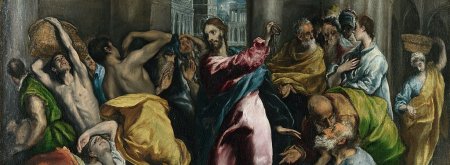Why Are There Differences in the Gospels?
The differences between the four Gospels have been noticed ever since they were first compiled and collected in the canon. Some have dismissed the Gospels on this basis as hopelessly contradictory. Others have offered harmonisations which take special pleading to the limit (six denials from Peter, anyone?). The message from Michael R. Licona, Associate Professor of Theology at Houston Baptist University, is that one can avoid either extreme and that we should not be overly worried by the differences in the Gospels. If we look at the Gospels in their literary context as Greco-Roman biographies and observe the compositional devices used by ancient writers when writing biography or history then we can see that the Gospel writers used the same approach. This goes a long way to explaining the differences as well as remembering ‘ancient biographical conventions provided authors a licence to depart from the degree of precision in reporting that many of us moderns prefer’ (5).
Learning from ancient literature
![]() Licona makes his case by examining different pericopes in Plutarch’s Lives,showing how Plutarch worked and reworked material when telling the same story in a different place or reworking the same material in more than one biography. By using Plutarch as a case study and drawing conclusions from him, we are in a position to see that the Gospels contain the same types of differences.
Licona makes his case by examining different pericopes in Plutarch’s Lives,showing how Plutarch worked and reworked material when telling the same story in a different place or reworking the same material in more than one biography. By using Plutarch as a case study and drawing conclusions from him, we are in a position to see that the Gospels contain the same types of differences.
The book has five chapters between the introduction and conclusion with four appendices. Chapter 1 looks at ancient compositional textbooks and how people learned rhetoric and were taught to paraphrase when telling a narrative. When retelling a story, writers could alter the syntax of a sentence or add words for clarification, further description or artistic improvement. They could subtract words or thoughts from the original, substitute words or combine these. A chapter then follows on Plutarch which will be useful to those who are reading this from a theological perspective and so may not so familiar with him (as I wasn’t) before examining 30 parallel pericopes that appear two or more times in Plutarch’s Lives. For each one, Licona (and the same goes for the chapter on the Gospels) gives narrative, analysis and then a summary before summarising the chapter. The conclusions reached are that:
On occasion, Plutarch errs. Only rarely do his accounts disagree on so many details that we are left puzzled and entirely unaware of what he is doing. The differences we observe almost always could have resulted from Plutarch’s use of the compositional devices that have been noted by classical scholars for some time and who have contended that these were standard conventions for writing history and biography of that day and were practiced by virtually all. Moreover, these differences appear to occur only in the peripheral details.
Examining the Gospels
With the case from Plutarch’s Lives thus established, Licona turns to the canonical Gospels. Some standard material appears which students of the New Testament will be more than familiar with. For example, the reasons for the canonical Gospels as those that give us our primary knowledge of Jesus; the various theories around the Synoptics and some comments on John. He then examines 16 pericopes appearing in two or more Gospels as they have ‘the best chance of containing differences resulting from the same type of compositional devices’ as seen from earlier in Plutarch. Licona’s conclusion from these is that,
In short, a very large majority of the differences we have observed could be the result of an evangelist using a different source or employing the compositional devices that were standard conventions for writing history and biography in his day. Moreover, these differences almost always appear in the peripheral details. (184)
A final chapter examines whether some of the pericopes may be explained by the compositional device of ‘synthetic chronological placement’ or historical displacement (where an event is placed at a different point in time). Licona again shows examples of this in authors such as Plutarch, Sallust and Tacitus. By the standards of history this technique was encouraged by people like Lucian, as it helped the narrative to flow. To my mind, this would fit with the claims of someone like Papias who claimed that Mark’s Gospel was written as self-contained teachings without them necessarily being in chronological order.
Taking things too far?
The book is very clear in its format and so is accessible and easy to find one’s way around. As someone reading from the angle of theology and apologetics I found the information on Plutarch, compositional techniques and the pericopes from the Lives to be interesting, but I imagine this would be standard fare for someone studying that world seriously. Licona makes sense of a lot of the differences in the Gospels by that showing that difference does not always mean a discrepancy and helping the reader to understand the compositional techniques used at the time.
Sometimes Licona concedes too much, for instance in the discussion on John’s Gospel where he writes, ‘John often chose to sacrifice accuracy on the ground level of precise reporting, preferring to provide his readers with an accurate, higher-level view of the person of Jesus and his mission’ (115) although this could be him stating the scholarly opinion. I much preferred the endnote quote from F.F. Bruce which acknowledged John as different without casting doubts on accuracy. Whilst not explaining all the differences between John and the Synoptics, I think much can be explained in terms of the different events when one remembers the setting of much of John and the occasions – much of which differ from the Synoptics.
Licona’s work will benefit anyone studying the Gospels and can act as a more in-depth Gospel Parallels or as a reference book for those wanting to look at his summary of the pericopes he covers. I suspect it will become a book that is often referenced with many accepting that the parallels with Plutarch do go some way, maybe even a long way to explaining the differences, unless someone comes along to challenge the findings. This will be because it will be of most benefit to New Testament students who, with the best will in the world, probably won’t spend a few hours wading through the long chapter on Plutarch’s Lives but will gratefully accept the heavy lifting Licona has done and piggyback on it…with gratitude. Whilst going a long way and destined to be a book that one will have to reference if doing serious work in this area, I think Licona may still end up between a rock and a hard place – although between a rock and a soft place might be a better description. What I mean is, the sceptic still won’t be convinced by the claims of the gospel and will still have questions around accuracy, whilst also not coming to the end for which the Gospels are written – to proclaim Jesus. Likewise, the inerrantist will have serious questions about Licona’s conclusions. On this note, I close with a quote from Mark L. Strauss’ review in the journal Themelios:
The challenge, of course, is whether ‘non-harmonizing’ solutions— even if they were common in the Greco-Roman world—cross the line from literary license to outright error. Do they violate the evangelical doctrine of the inerrancy of Scripture? One’s evaluation of Licona’s work will depend in part on their definition of inspiration and inerrancy and the qualifications one places on these doctrines. While many will find Licona’s conclusions reasonable and convincing (for the most part I did), others may conclude he has crossed a bridge too far.[1]
Michael R. Licona, Why Are There Differences in the Gospels? (OUP USA, 2017) 336pp
References
[1] Mark L Strauss, 'Review: Why are there differences in the gospels?' Themelios 42.1 (2017): 175-177



